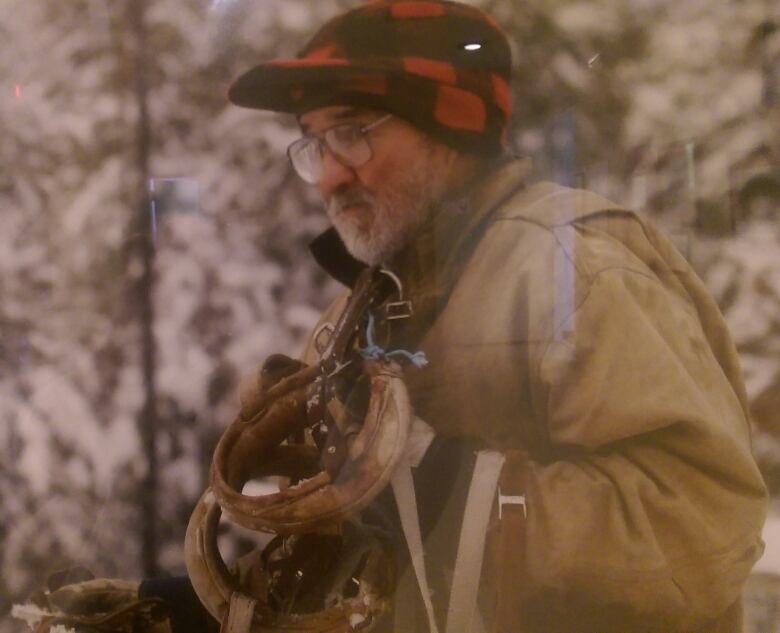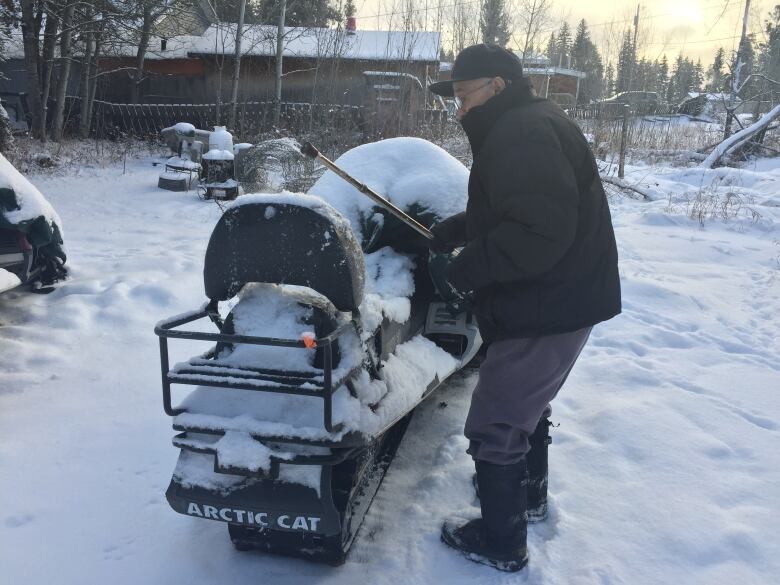On 90th birthday, N.W.T. trapping legend Pi Kennedy reflects on a life in the bush
'I'm just sitting here enjoying the last years of my life,' says man who spent 80 winters outdoors

Wendy Stephenson and her husband John were on a three-month canoe trip when the voice of a legend came crackling over the bush radio.
"I said, 'Oh, you're Pi Kennedy!" she recalls. She had just seen an exhibit featuring photographs and artifacts from his life at the Fort Smith museum, and here he was in real life, coming through over the air.
"It's kind of strange how we met, and I'm happy that we did."
Over the following month, the couple would talk with Kennedy just about every night over the radio. He would tell them about the old days of trapping and share hisknowledge earned from years onthe land.
When they returned to Yellowknife, the couple immediately made plans to visit Kennedy in Fort Smith, and kicked off a decade-long friendship that continues to this day.
"He's a genuine person that listens, loves to tell stories, loves to try to figure things out," she says. "He's a good example of how to live life."
- Trapper's life in the bush on display at Fort Smith, N.W.T., museum
- Andrew Stanley, N.W.T. trapper on YouTube, gets reality TV show
Every winter but 1 in the bush
Born in 1926, Kennedy has indeed lived a remarkable life. Until six years ago, he spent every winter but one in the bush:trapping, fishing,hunting, and listening religiously to Los Angeles Dodgers baseball games on his bush radio, miles from the nearest human being.
Kennedy was eight years old when he spent his first winter on atrapline.

"I had no choice; see, my dad, he was sick," he says. "It was 1933 when he took me to Fort Res to go to school, and the next year, he came and got me to go in the bush with him because he was not well."
Kennedylived that way until 2010, when, at 84, he found himself incapacitated while he was out at his cabin.
"I ate some ham. I got sick with that. At least I think so," he says. "But then I had a stroke, so maybe it was not the ham."
WhenStephensondidn't hear from Kennedy for a few days, which was unusual,she grew worried and called in a rescue plane. He credits her with saving his life.
"I was shivering in a little blanket," he says. "And the worst part of it was that my dogs didn't eat."
'I could see the winters were getting warmer'
His dogs were "the reason he got up every morning," saysStephenson. He had to put the last of them down last year.
But Kennedyand those dogs named for world leaders like Tony Blair andGeorge Bush, as well as the "bad ones" namedKhomeniandGaddafihave travelled countless miles along histraplineand witnessed the social and geographical changes in the region.
"I could see the winters were getting warmer. That was a long time ago, around 20 years. I noticed that right away," he says. He would wear a life jacket while riding on his skidoo in case he fell through the ice.This year, in November, he said he wouldn't dare cross the Slave River, a crossing he used to do in October.

He didn't just remember these things, though. A keen photographer, he documented everything, and about 1,000 of his photographs are currently in the Prince of Wales Northern Heritage Centre being prepared for future display.
"It's hard to express how vital these stories are to our culture and our heritage," says ErinSuliak, who is working with the materials Kennedy donated.
Unlike many records of traditional practices in the North, taken by outsiders, Kennedy created a record himself of what his own life was like. That, toSuliak, adds an invaluable extra dimension.
"The N.W.T. archives can be considered like the photo album of the North," she says.
"His is going to be an amazing chapter in that photo book."
- 'Not my choice to leave:' retired Anglican priest reflects on 60 years in the Arctic
- N.W.T. couple welcomes 'showers of blessings' on 77th anniversary
- 'I'm gonna miss the reindeer': Inuvik's chief reindeer herder hangs up his lasso
A changing North
The chapter in N.W.T. history of which Kennedy has been a central part is reaching its denouement.
Fewer and fewer trappers are spending winters on the land. Even a decade ago, when LibbyGunnwas following him around for an exhibition the same one thatStephensonwould see before she met him Gunnwas trying to document one of the last holdouts of the era.
"When we were flying out there, he would look down at the bush, sadly, and say, 'There's nobody down there anymore,'" she says.
Even the radio that had brought him so much joy, and the friendship of people likeStephenson, and which eventually saved his life, has fallen silent.
"He talked about how on Christmas day, the radio used to just crackle, with everybody passing Christmas wishes back and forth," she says.
"Even on Christmas day, now, the radio was quiet."

- Norwegian adventurer spends 6 months alone in the N.W.T. wilderness
- Sleeping under Arctic skies, Japanese adventurer, 20, cycles to Tuktoyaktuk
Birthday party today
A celebration is planned in Fort Smith today for Kennedy's 90th birthday.
"I'm just sitting here enjoying the last years of my life," he says.
He has two snowmobiles parked out back. One, he has given up on; the other, he brushes snow off to lift the cover and point out a part he has on order.
"I want to go skidooing, but I've got to be careful.I don't want to drive too fast. I don't want to tip over."












_(720p).jpg)


 OFFICIAL HD MUSIC VIDEO.jpg)
.jpg)



























































































